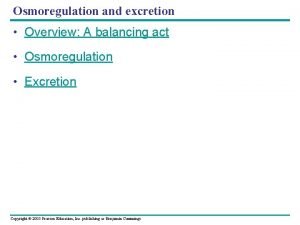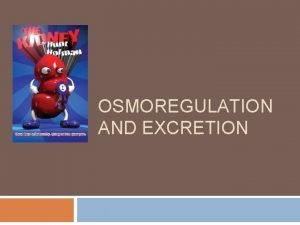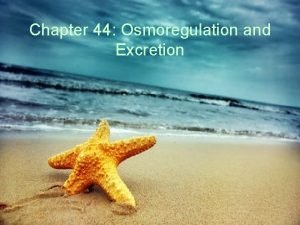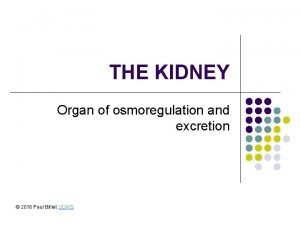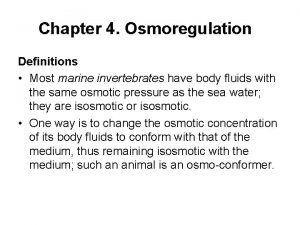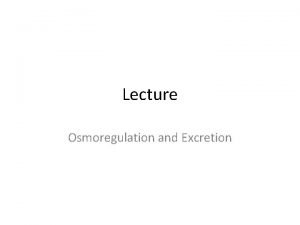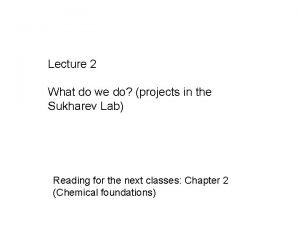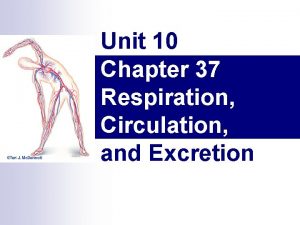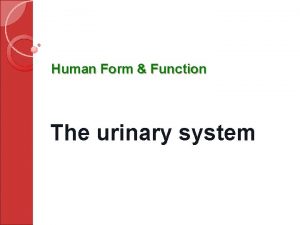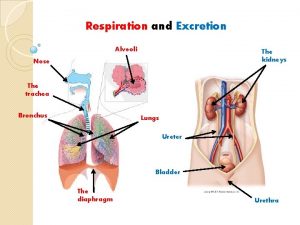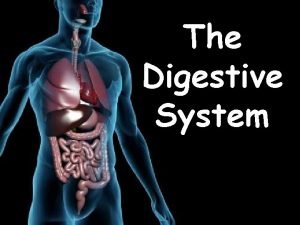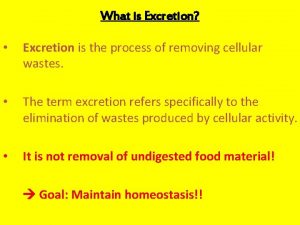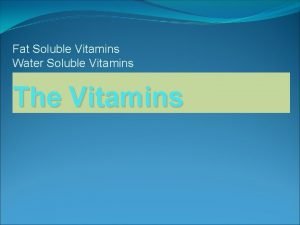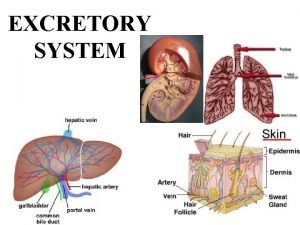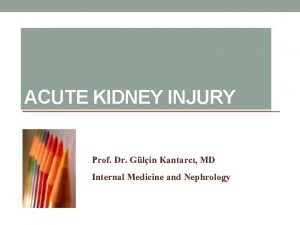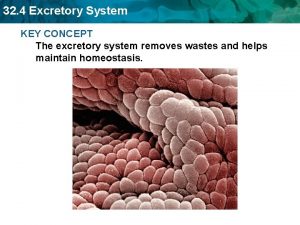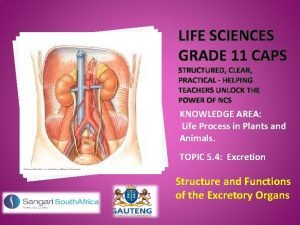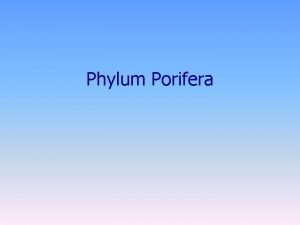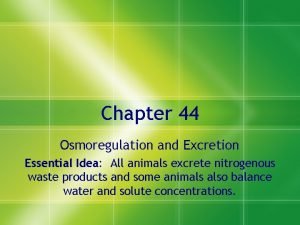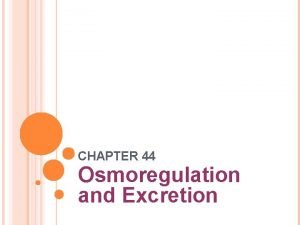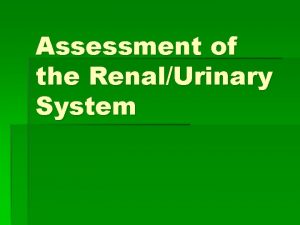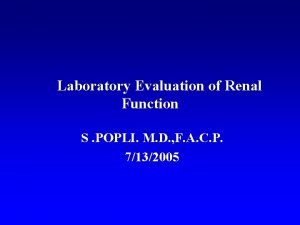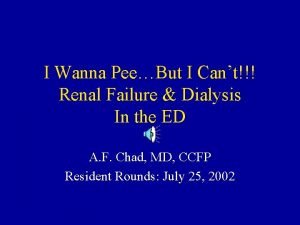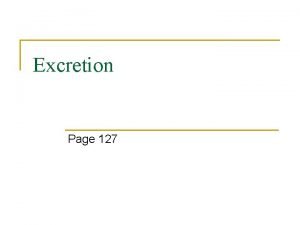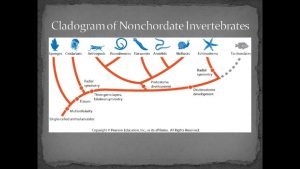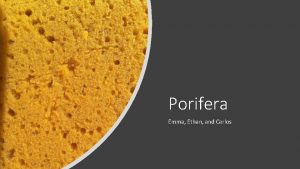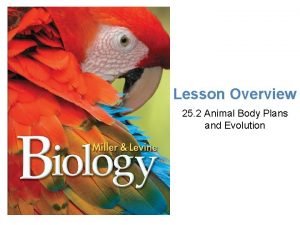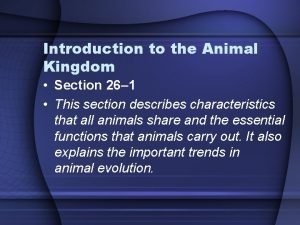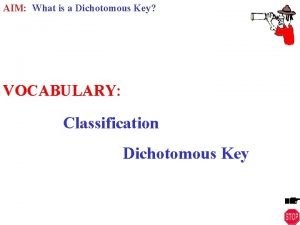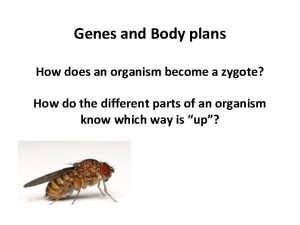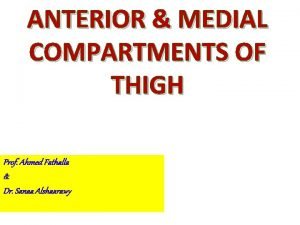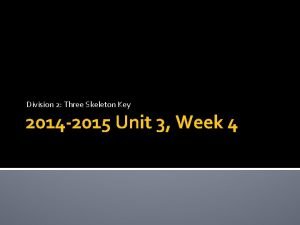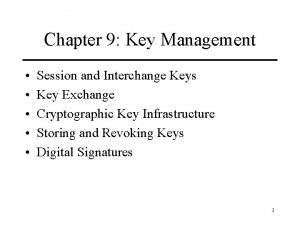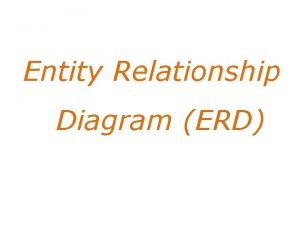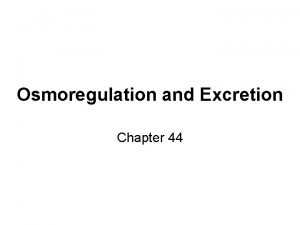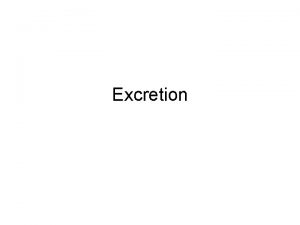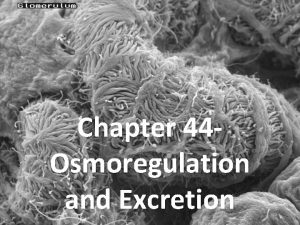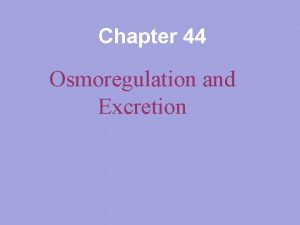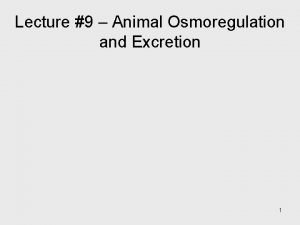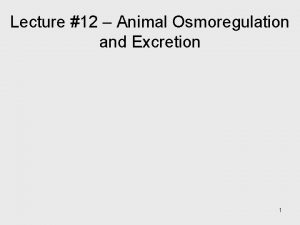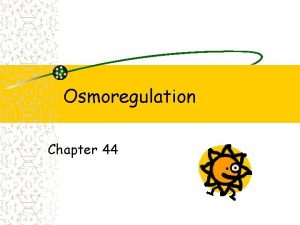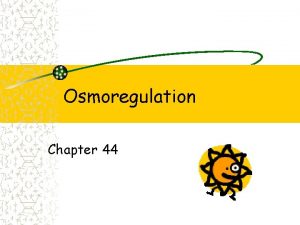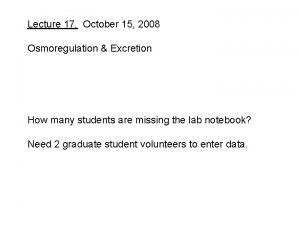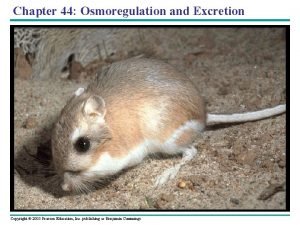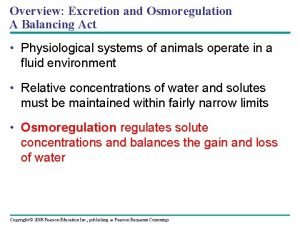Lecture 11 Animal Osmoregulation and Excretion 1 Key



























































































- Slides: 91

Lecture #11 – Animal Osmoregulation and Excretion 1

Key Concepts • Water and metabolic waste • The osmotic challenges of different environments • The sodium/potassium pump and ion channels • Nitrogenous waste • Osmoregulation and excretion in invertebrates • Osmoregulation and excretion in vertebrates 2

Water and Metabolic Waste • All organismal systems exist within a water based environment ØThe cell solution is water based ØInterstitial fluid is water based ØBlood and hemolymph are water based • All metabolic processes produce waste ØMetabolic processes that produce nitrogen typically produce very toxic ammonia 3

Critical Thinking • The cellular metabolism of _______ will produce nitrogenous waste. 4

Critical Thinking • The cellular metabolism of ______ will produce nitrogenous waste. 5

Water and Metabolic Waste • All animals have some mechanism to regulate water balance and solute concentration • All animals have some mechanism to excrete nitrogenous waste products • Osmoregulation and excretion systems vary by habitat and evolutionary history 6

Animals live in different environments Marine…. Freshwater…. Terrestrial All animals must balance water uptake vs. water loss and regulate solute concentration within cells and tissues 7

The osmotic challenges of different environments – water balance • Water regulation strategies vary by environment ØBody fluids range from 2 -3 orders of magnitude more concentrated than freshwater ØBody fluids are about one order of magnitude less concentrated than seawater for osmoregulators ØBody fluids are isotonic to seawater for osmoconformers ØTerrestrial animals face the challenge of 8 extreme dehydration

The osmotic challenges of different environments – solute balance • All animals regulate solute content, regardless of their water regulation strategy • Osmoregulation always requires metabolic energy expenditure 9

The osmotic challenges of different environments – solute balance • In most environments, ~5% of basal metabolic rate is used for osmoregulation ØMore in extreme environments ØLess for osmoconformers • Strategies involve active transport of solutes and adaptations that adjust tissue solute concentrations 10

Water Balance in a Marine Environment • Marine animals that regulate water balance are hypotonic relative to salt water (less salty) • Where does water go? ? ? 11

Critical Thinking • Marine animals that regulate water balance are hypotonic relative to salt water – where does water go? ? ? 12

Critical Thinking • Marine animals that regulate water balance are hypotonic relative to salt water – where does water go? ? ? 13

Critical Thinking • Marine animals that regulate water balance are hypotonic relative to salt water – where does water go? ? ? 14

Water Balance in a Marine Environment • Marine animals that regulate water balance are hypotonic relative to salt water ØThey dehydrate and must drink lots of water ØMarine bony fish excrete very little urine • Most marine invertebrates are osmoconformers that are isotonic to seawater ØWater balance is in dynamic equilibrium with surrounding seawater 15

Solute Balance in a Marine Environment • Marine osmoregulators ØGain solutes because of diffusion gradient ØExcess sodium and chloride transported back to seawater using metabolic energy, a set of linked transport proteins, and a leaky epithelium ØKidneys filter out excess calcium, magnesium and sulfates • Marine osmoconformers ØActively regulate solute concentrations to maintain homeostasis 16

Specialized chloride cells in the gills actively accumulate chloride, resulting in removal of both Cl- and Na+ Figure showing how chloride cells in fish gills regulate salts 17

Solute Balance in a Marine Environment • Marine osmoregulators ØGain solutes because of diffusion gradient ØExcess sodium and chloride transported back to seawater using metabolic energy, a set of linked transport proteins, and a leaky epithelium ØKidneys filter out excess calcium, magnesium and sulfates • Marine osmoconformers ØActively regulate solute concentrations to maintain homeostasis 18

Water Balance in a Freshwater Environment • All freshwater animals are regulators and hypertonic relative to their environment (more salty) • Where does water go? ? ? 19

Critical Thinking • All freshwater animals are regulators and hypertonic relative to freshwater – where does water go? ? ? 20

Critical Thinking • All freshwater animals are regulators and hypertonic relative to freshwater – where does water go? ? ? 21

Water Balance in a Freshwater Environment • All freshwater animals are regulators • They are constantly taking in water and must excrete large volumes of urine ØMost maintain lower cytoplasm solute concentrations than marine regulators – helps reduce the solute gradient and thus limits water uptake • Some animals can switch environments and strategies (salmon) 22

Some animals have the ability to go dormant by extreme dehydration 23

Solute Balance in a Freshwater Environment • Large volume of urine depletes solutes ØUrine is dilute, but there are still losses • Active transport at gills replenishes some solutes • Additional solutes acquired in food 24

Marine osmoregulators dehydrate and drink to maintain water balance; regulate solutes by active transport Freshwater animals gain water, pee alot to maintain water balance; regulate solutes by active transport Figure showing a comparison between osmoregulation strategies of marine and freshwater fish 25

Water Balance in a Terrestrial Environment • Dehydration is a serious threat ØMost animals die if they lose more than 10 -12% of their body water • Animals that live on land have adaptations to reduce water loss 26

Critical Thinking • Animals that live on land have adaptations to reduce water loss – such as? ? ? 27

Critical Thinking • Animals that live on land have adaptations to reduce water loss – such as? ? ? 28

Solute Balance in a Terrestrial Environment • Solutes are regulated primarily by the excretory system ØMore later 29

The sodium/potassium pump and ion channels in transport epithelia • ATP powered Na+/Cl- pumps regulate solute concentration in most animals Ø First modeled in sharks, later found in other animals • Position of membrane proteins and the direction of transport determines regulatory function Ø Varies between different groups of animals Figure showing the Na/K pump and membrane ion channels. This figure is used in the next 9 slides. 30

The Pump • Metabolic energy is used to transport K+ into the cell and Na+ out ØThis produces an electrochemical gradient 31

Critical Thinking • What kind of electrochemical gradient? ? ? 32

Critical Thinking • What kind of electrochemical gradient? ? ? 33

Critical Thinking • What kind of electrochemical gradient? ? ? 34

The Na+/Cl-/K+ Cotransporter • A cotransporter protein uses this gradient to move sodium, chloride and potassium into the cell 35

The Na+/Cl-/K+ Cotransporter • Sodium is cycled back out • Potassium and chloride accumulate inside the cell 36

Selective Ion Channels • Ion channels allow passive diffusion of chloride and potassium out of the cell • Placement of these channels determines direction of transport – varies by animal 37

Additional Ion Channels • In some cases sodium also diffuses between the epithelial cells ØShark rectal glands ØMarine bony fish gills 38

Additional Ion Channels • In other animals, chloride pumps, additional cotransporters and aquaporins are important ØMembrane structure reflects function 39

Nitrogenous Waste • Metabolism of proteins and nucleic acids releases nitrogen in the form of ammonia • Ammonia is toxic because it raises p. H • Different groups of animals have evolved different strategies for dealing with ammonia, based on environment Figure showing different forms of nitrogenous waste in different groups of animals 40

Critical Thinking • Why does ammonia raise p. H? ? ? • Remember chemistry…… 41

Critical Thinking • Why does ammonia raise p. H? ? ? • Remember chemistry. . … 42

Critical Thinking • Why does ammonia raise p. H? ? ? • Remember chemistry. . … 43

Nitrogenous Waste • Metabolism of proteins and nucleic acids releases nitrogen in the form of ammonia • Ammonia is toxic because it raises p. H • Different groups of animals have evolved different strategies for dealing with ammonia, based on environment 44

Nitrogenous Waste • Most aquatic animals excrete ammonia or ammonium directly across the skin or gills • Plenty of water available to dilute the toxic effects • Freshwater fish also lose ammonia in their very dilute urine 45

Nitrogenous Waste • Most terrestrial animals cannot tolerate the water loss inherent in ammonia excretion • They use metabolic energy to convert ammonia to urea • Urea is 100, 000 times less toxic than ammonia and can be safely excreted in urine 46

Nitrogenous Waste • Insects, birds, many reptiles and some other land animals use even more metabolic energy to convert ammonia to uric acid • Uric acid is excreted as a paste with little water loss • Energy expensive 47

Osmoregulation and excretion in invertebrates • Earliest inverts still rely on diffusion ØSponges, jellies • Most inverts have some variation on a tubular filtration system • Three basic processes occur in a tubular system that penetrates into the tissues and opens to the outside environment ØFiltration ØSelective reabsorption and secretion ØExcretion 48

Protonephridia in flatworms, rotifers, and a few other inverts • System of tubules is diffusely spread throughout the body • Beating cilia at the closed end of the tube draw interstitial fluid into the tubule • Solutes are reabsorbed before dilute urine is excreted Figure showing flatworm protonephridia 49

Protonephridia in flatworms, rotifers, and a few other inverts • In freshwater flatworms most N waste diffuses across the skin or into the gastrovascular cavity ØExcretion 1 o maintains water and solute balance • In other flatworms, the protonephridia excrete nitrogenous waste 50

Metanephridia in the earthworms • Tubules collect body fluid through a ciliated opening from one segment and excrete urine from the adjacent segment • Hydrostatic pressure facilitates collection Figure showing annelid metanephridia 51

Metanephridia in the earthworms • Vascularized tubules reabsorb solutes and maintain water balance • N waste is excreted in dilute urine 52

Critical Thinking • Earthworms are terrestrial – why would they have to get rid of excess water by producing dilute urine? ? ? 53

Critical Thinking • Earthworms are terrestrial – why would they have to get rid of excess water by producing dilute urine? ? ? 54

Malphigian tubules in insects and other terrestrial arthropods • System of closed tubules uses ATPpowered pumps to transport solutes from the hemolymph • Water follows ψ gradient into the tubules Figure showing arthropod malphigian tubules. Same or similar figure is used in the next 3 slides. 55

Malphigian tubules in insects and other terrestrial arthropods • Nitrogenous wastes and other solutes diffuse into the tubules on their gradients • Dilute filtrate passes into the digestive tract 56

Malphigian tubules in insects and other terrestrial arthropods • Solutes and water are reabsorbed in the rectum ØAgain, using ATPpowered pumps 57

Malphigian tubules in insects and other terrestrial arthropods • Uric acid is excreted from same opening as digestive wastes • Mixed wastes are very dry • Effective water conservation has helped this group become so successful on land 58

Osmoregulation and excretion in vertebrates • Almost all vertebrates have a system of tubules (nephrons) in a pair of compact organs – the kidneys • Each nephron is vascularized • Each nephron drains into a series of coalescing ducts that drain urine to the external environment • Many adaptations to different environments ØMost adaptations alter the concentration and volume of excreted urine 59

Critical Thinking • Which of the world’s environments has produced the most concentrated urine? ? ? 60

Critical Thinking • Which of the world’s environments has produced the most concentrated urine? ? ? 61

The Human Excretory System • Kidneys filter blood and concentrate the urine • Ureter drains to bladder • Bladder stores • Urethra drains urine to the external environment Diagram of the human excretory system 62

The Human Excretory System • Each kidney is composed of nephrons ØThese are the functional sub-units of the kidney • Each nephron is vascularized Diagram of the human excretory system showing closeup of nephron 63

Critical Thinking • Each nephron is vascularized…. . • What exactly does that mean? ? ? 64

Critical Thinking • Each nephron is vascularized…. . • What exactly does that mean? ? ? 65

Nephron Structure • Each nephron starts at a cup-shaped closed end ØCorpuscle ØSite of filtration Diagram of nephron structure • Next is the proximal convoluted tubule in the outer region of the kidney (cortex) 66

Nephron Structure • The Loop of Henle descends into the inner region of the kidney (medulla) • The distal tubule drains into the collecting duct ØAll these tubules are involved with secretion, reabsorption and the concentration of urine 67

Remember the 2 major steps to urine formation: • Filtration and reabsorption/secretion • Enormous quantities of blood are filtered daily Ø 1, 100 – 2, 000 liters of blood filtered daily Ø~180 liters of filtrate produced daily • Most water and many solutes are reabsorbed; some solutes are secreted Ø~1. 5 liters of urine produced daily • Water conservation!!! 68

Filtration in the Corpuscle • Occurs as arterial blood enters the glomerulus ØA capillary bed with unusually porous epithelia • Blood enters AND LEAVES the glomerulus under pressure • Glomerulus is surrounded by Bowman’s Capsule ØThe invaginated but closed end of the nephron ØThe enclosed space creates pressure 69

Filtration in the Corpuscle Diagram of renal corpuscle 70

Filtration in the Corpuscle • The interior epithelium of Bowman’s Capsule has special cells with finger-like processes that produce slits • The slits allow the passage of water, nitrogenous wastes, many solutes • Large proteins and red blood cells are too large to be filtered out and remain in the arteriole 71

Epithelial cells lining Bowman’s Capsule have extensions that make filtration slits – podocytes! Diagram of podocytes and porous capillary 72

Materials are filtered through pores in the capillary epithelium, across the basement membrane and through filtration slits into the lumen of Bowman’s Capsule, passing then into the tubule 73

Filtration in the Corpuscle • Anything small enough to pass makes up the initial filtrate ØWater ØUrea ØSolutes ØGlucose ØAmino acids ØVitamins… • Filtration forced by blood pressure • Large volume of filtrate produced (180 l/day) 74

Stepwise – From Filtrate to Urine Diagram showing overview of urine production 75

The Proximal Tubule • Secretion – substances are transported from the blood into the tubule • Reabsorption – substances are transported from the filtrate back into the blood 76

The Proximal Tubule – Secretion • Body p. H is partly maintained by secretion of excess H+ ØProximal tubule epithelia cells also make and secrete ammonia (NH 3) which neutralizes the filtrate p. H by bonding to the secreted protons • Drugs and other toxins processed by the liver are secreted into the filtrate 77

The Proximal Tubule – Reabsorption • Tubule epithelium is very selective • Waste products remain in the filtrate • Valuable resources are transported back to the blood ØWater (99%) ØNa. Cl, K+ ØGlucose, amino acids ØBicarbonate ØVitamins… 78

The Proximal Tubule – Reabsorption • ATP powered Na+/Cl- pump builds gradient • Transport molecules speed passage ØNote increased surface area facing tubule lumen Diagram of tubule membrane proteins including Na/K pump 79

Critical Thinking • What’s driving water transport? ? ? 80

Critical Thinking • What’s driving water transport? ? ? 81

The Loop of Henle • Differences in membrane permeability set up osmotic gradients that recover water and salts and concentrate the urine 82

Three Regions Diagram of Loop of Henle. This diagram is used in the next 3 slides 83

The Descending Limb • Permeable to water • Impermeable to solutes • Water is recovered because of the increase in solutes in the surrounding interstitial fluids from the cortex to the inner medulla 84

The Thin Ascending Limb • Not permeable to water • Very permeable to Na+ and Cl • These solutes are recovered through passive transport • Solutes help maintain the interstitial fluid gradient 85

The Thick Ascending Limb • Na+ and Cl- continued to be recovered by active transport • High metabolic cost, but helps to maintain the gradient that concentrates urea in the urine 86

The Distal Tubule • Filtrate entering the distal tubule contains mostly urea and other wastes • Na+, Cl- and water continue to be reabsorbed Diagram of the distal tubule and collecting duct. This diagram is used in the next 2 slides. ØThe amount depends on body condition ØHormone activity maintains Na+ homeostasis • Some secretion also occurs 87

The Collecting Duct • The final concentration of urine occurs as the filtrate passes down the collecting duct and back through the concentration gradient in the interstitial fluid of the kidney ØWater reabsorption is regulated by hormones to maintain homeostatis ØDehydrated individuals produce more concentrated urine 88

The Collecting Duct • Some salt is actively transported • The far end of the collecting duct is permeable to urea • Urea trickles out into the inner medulla ØHelps establish and maintain the concentration gradient 89

The Big Picture • Blood is effectively filtered to remove nitrogenous waste • Filtrate is effectively treated to isolate urea and return the good stuff to the blood • Water is conserved – an important adaptation to terrestrial conditions 90

REVIEW – Key Concepts • Water and metabolic waste • The osmotic challenges of different environments • The sodium/potassium pump and ion channels • Nitrogenous waste • Osmoregulation and excretion in invertebrates • Osmoregulation and excretion in vertebrates 91
 Tonicity and osmoregulation
Tonicity and osmoregulation Osmoregulation
Osmoregulation Osmoregulation
Osmoregulation Osmoregulation
Osmoregulation Renal artery branches
Renal artery branches Osmoregulation in invertebrates
Osmoregulation in invertebrates Protonephridia
Protonephridia Osmoregulation
Osmoregulation Homeostasis and evolution
Homeostasis and evolution 01:640:244 lecture notes - lecture 15: plat, idah, farad
01:640:244 lecture notes - lecture 15: plat, idah, farad Chapter 37 respiration circulation and excretion
Chapter 37 respiration circulation and excretion Excretion and elimination
Excretion and elimination Respiration and excretion
Respiration and excretion Cardiac sphincter
Cardiac sphincter Digestion and excretion lesson 3
Digestion and excretion lesson 3 What is excretion
What is excretion Zero order elimination drugs
Zero order elimination drugs Difference between fat soluble and water soluble vitamins
Difference between fat soluble and water soluble vitamins Process of excretion
Process of excretion What is excretion
What is excretion Fractional excretion of sodium
Fractional excretion of sodium Process of excretion
Process of excretion Nicotine excretion
Nicotine excretion What is excretion
What is excretion Vitamin e excretion
Vitamin e excretion Excretion grade 11
Excretion grade 11 Food from plants
Food from plants Porifera
Porifera Excretory organ of insects
Excretory organ of insects Excretion
Excretion Hagfish excretory system
Hagfish excretory system Excretion
Excretion Excretion
Excretion Excretion
Excretion Summary of drug administration
Summary of drug administration Urine
Urine Fractional excretion of sodium
Fractional excretion of sodium Diasylate
Diasylate Excretion in animals
Excretion in animals Metabolic waste
Metabolic waste Circulation in porifera
Circulation in porifera Porifera excretion
Porifera excretion Key partners canvas
Key partners canvas Business model canvas tripadvisor
Business model canvas tripadvisor Venn diagram for animal and plant cells
Venn diagram for animal and plant cells Animal rights versus animal welfare
Animal rights versus animal welfare Venn diagram plant and animal cell
Venn diagram plant and animal cell Lesson 2: animal body plans: 1
Lesson 2: animal body plans: 1 Chapter 3 questions animal farm
Chapter 3 questions animal farm Betrayal in animal farm
Betrayal in animal farm What enables motile animals to move around
What enables motile animals to move around Chapter 24 body plans of animals with bilateral symmetry
Chapter 24 body plans of animals with bilateral symmetry Dichotomous key for cars
Dichotomous key for cars Animal body plans homeobox genes answer key
Animal body plans homeobox genes answer key Magnetism
Magnetism Power system dynamics and stability lecture notes
Power system dynamics and stability lecture notes Microbial physiology lecture notes
Microbial physiology lecture notes Ternology
Ternology Cloud computing lecture
Cloud computing lecture Fundamental deviation table
Fundamental deviation table Financial markets and institutions ppt
Financial markets and institutions ppt Indirect finance
Indirect finance Extempore and lecture
Extempore and lecture Utilities and energy lecture
Utilities and energy lecture Catherine belsey books
Catherine belsey books Mechatronics ppt
Mechatronics ppt Foetotomy
Foetotomy Lecture on love courtship and marriage
Lecture on love courtship and marriage Power system dynamics and stability lecture notes
Power system dynamics and stability lecture notes Project planning and management lecture notes ppt
Project planning and management lecture notes ppt Femoral triangle
Femoral triangle Concept map minerals
Concept map minerals Dichotomous key for beetles
Dichotomous key for beetles Key concept builder lesson 1 what are waves answer key
Key concept builder lesson 1 what are waves answer key What is the theme of three skeleton key
What is the theme of three skeleton key Interchange kets
Interchange kets Penjelasan erd
Penjelasan erd Project procurement management lecture notes
Project procurement management lecture notes Lecture about sport
Lecture about sport Healthy lifestyle wrap up lecture
Healthy lifestyle wrap up lecture Meaning of this
Meaning of this Life lecture meaning
Life lecture meaning Randy pausch the last lecture summary
Randy pausch the last lecture summary Tensorflow lecture
Tensorflow lecture Theology proper lecture notes
Theology proper lecture notes Strategic management lecture
Strategic management lecture Geology lecture series
Geology lecture series Social psychology lecture
Social psychology lecture In text citation for a lecture
In text citation for a lecture Public sector accounting notes
Public sector accounting notes Software project management lecture notes
Software project management lecture notes Eurocode lap lengths
Eurocode lap lengths

